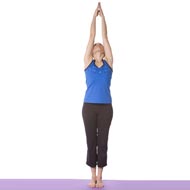- Aromatherapy (36)
- Benefits of Yoga (282)
- Home Remedies (1087)
- massage therapy (9)
- Preventive Therapy (135)
- Running (41)
- Skin Care (15)
- Stress Relief (25)
- Stretching (5)
- walking (33)
- Womens Health (14)
- Yoga Benefits for Pregnant Women (16)
- Yoga Benefits for Students (3)
- Yoga for Children (11)
- Yoga for Holistic Living (37)
- Yoga for Midlife Crisis (3)
- Yoga for Senior Citizens (2)
- Yoga for the Workplace (1)
- Yoga Health Tips (185)
- Yoga Practice during Menstruation (5)
How Long You Should Hold A Yoga Posture?

There is no hard and fast rule as to how long you should hold a yoga pose for. While some institutions prescribe the minimum ratio of 2 (inhalation to enter the pose): 4 (retention): 2 (exhalation to exit the pose): 2 (suspension), there are those who advocate holding poses for anywhere from 5 – 10 – 15 – 20 seconds even. This varies from pose to pose as well as depending on your experience with the poses.
Take for instance a simple standing pose like Tadasana (Mountain Pose). Even though, to many it doesn't even qualify as a yoga pose, it does in fact have its own benefits and contraindications and can safely be held for up to five or ten minutes, depending upon your stamina and the state of your legs. Then there are sitting poses such as Sukhasana (Easy Pose) which, experience will tell are far from easy. Sit in a cross legged position on your yoga mat, place your hands on your thighs and shut your eyes. Now concentrate on your breathing and see how long you are able to hold the pose. Most practitioners are barely able to sit comfortably for even a minute, at the start. In fact, even many advanced students report being unable to sit in Sukhasana (Easy Pose) for more than a minute at a stretch, eyes closed.
Then there are prone poses such as Bhujangasana (Cobra Pose), Dhanurasana (Bow Pose) and Shalabhasana (Locust Pose) that even adepts do not hold for more than a minute. On the other hand, certain poses such as Sirshasana (Head Stand) and Sarvangasana (Shoulder Stand) may comfortably be held with practice for up to ten minutes. Here again, different schools of Yoga have differing views. It actually all depends upon a variety of factors including your gender, age, physical fitness, medical health, flexibility and needs.
There is a misconception that the longer you hold a pose, the more the benefits. This is not necessarily true; not for all poses. Some poses, including Mayurasana (Peacock Pose), Garudasana (Eagle Pose), Kakasana (Crow Pose), Bakasana (Crane Pose) and Mandukasana (Frog Pose), to name a few, should not be held for more than a couple seconds at most. The meditative poses such as Sukhasana (Easy Pose), Padmasana (Lotus Pose) and Vajrasana (Thunderbolt Pose) are intended to be held for the longest periods of time, as they prepare you for Pranayama (Breathing Exercises) and Meditation. Certain inverted poses, such as those mentioned above, may be held for long. Then again, inverted poses such as Halasana (Plow Pose) should not be held for more than a minute at the most.
If you are seriously interested in pursuing Yoga, it is best that you enroll into a Yoga institution and seek expert guidance.
- RSS Feeds -
- All posts
- All comments
- Reduce Weight with Pilates Ball Exercise Pilates ball exercise is good and it shows good results for weight reduction....
- Exercises for hyperextended knee Whenever the knee flexes in the opposite direction and extends beyond the straig...
- What is Mindfulness Meditation? Meditation is a form of exercise for the mind. In almost every culture there ...
- Yoga For Men If you've started practicing yoga recently or are still thinking about yo...